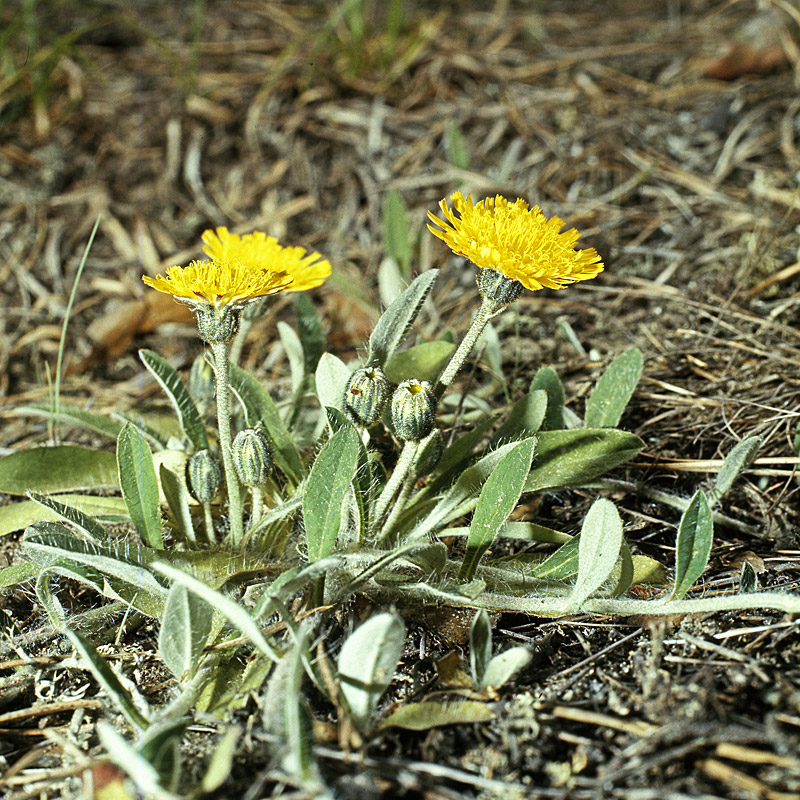Botanical name
Pilosella officinarum Vaill. (Syn.: Hieracium pilosella L.)
Family
Asteraceae
Common name
Mouse-ear hawkweed
Information about the plant
Mouse-ear hawkweed grows throughout most of Europe; in Portugal, Spain, and Greece, it is found only in the northern parts of these countries, and it is absent in Sicily and Sardinia. In Northern Europe, it extends up to the 65th parallel, and in the east, just beyond the Urals. It is also present in large areas of North America.
The genus Hieracium is one of the most diverse in the plant kingdom. In Germany, it is represented by two subgenera, which, in addition to their main and intermediate species, include countless subspecies, varieties, and forms, partly due to the fact that individual species tend to hybridize. The subgenera Pilosella (mouse-ear hawkweed) and Hieracium (true hawkweed) are distinguished based on their fruit shape. Mouse-ear hawkweed belongs to the subgenus Pilosella, characterized by fruits with 10 toothed ribs, a single-rowed pappus (the fruit's flight organ), and entire-margined leaves. According to the latest findings, the botanically correct name is Pilosella officinarum Vaill., although the plant is usually still referred to in the literature under the long-established name Hieracium pilosella L., which is now used as a synonym.
Hieracium comes from the Latin or Greek name of the plant, derived from the Latin ‘hieracium’ or Greek ‘hierakion’, with the Greek root ‘hierax’ (= falcon, hawk). Pilosella is a medieval name; its etymology is not known. It possibly refers to the hairiness of the plant, as the Latin ‘pilus’ means a (single) hair. The species epithet officinarum suggests that it is an old medicinal plant, as the ‘officina’ is the salesroom of a pharmacy, and “officinalis” means commonly used in the pharmacy.
Mouse-ear hawkweed grows to 10 to 30 cm tall. The leafless stem bears a terminal flower head that emerges from a rosette of broad-lanceolate leaves. The plant forms many long stolons with leaves covered in white felt on the underside, becoming progressively smaller towards the end. The yellow flower heads consist of numerous golden-yellow, hermaphrodite ray florets, with red stripes on the outside. The flowering period is from May to October.
Medicinally used parts of plants (herbal drug)
The dried plant, including aerial parts and roots, harvested in August/September (mouse-ear hawkweed with root - Pilosellae herba cum radice), is used. The dried herb without roots can also be used.
Constituents of the herbal drug
Mouse-ear hawkweed with root contains flavonoids, tannins, bitter substances, coumarins, and mucilage.
Quality of the drug
No pharmacopoeial quality description for mouse-ear hawkweed with roots (Pilosellae herba cum radice) is available.
Medical applications
Recognised medical use
The HMPC has classified mouse-ear hawkweed with root as a traditional herbal medicinal product (see ‘Traditional use’).
ESCOP: Mouse-ear hawkweed has not been evaluated.
Traditional use
The HMPC has classified mouse-ear hawkweed with root as a traditional herbal medicinal product (Article 16a of Directive 2001/83/EC). Based upon long-standing use, mouse-ear hawkweed with root can be used to increase the amount of urine and thus to flush the urinary tract as a supportive treatment for mild urinary tract complaints.
Herbal drug preparations in finished dosage forms
- Cut hawkweed with root for tea preparation
- Powdered drug
Dosage
Finished medicinal product: not applicable.
Tea: Drink a cup of hawkweed tea 3 times a day. Powdered hawkweed: single dose: 280 to 520 mg; daily dose 1300 mg.
Preparation of a tea
Pour 150 mL of boiling water over 2 to 3 g of the cut drug and strain after 10 minutes.
Notes
In case of existing allergies to Asteraceae, preparations made from hawkweed should not be taken due to the risk of cross-allergy.
In cases of urinary tract infection, drink sufficient fluids. In the presence of edema due to impaired heart and kidney function, flushing therapy with hawkweed should not be used.
No safety studies have yet been published on the use of hawkweed during pregnancy or lactation. Its use in children and adolescents under the age of 18 is not recommended due to a lack of evidence.
Side effects
None known.
Interactions
None known.


